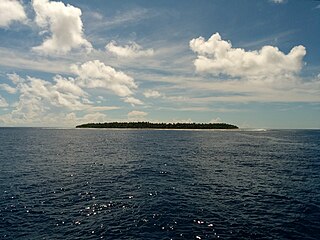Related Research Articles

The Cook Islands is a self-governing island country in the South Pacific Ocean in free association with New Zealand. It comprises 15 islands whose total land area is 240 square kilometres (93 sq mi). The Cook Islands' Exclusive Economic Zone (EEZ) covers 1,960,027 square kilometres (756,771 sq mi) of ocean.

Penrhyn is an atoll in the northern group of the Cook Islands in the south Pacific Ocean. The northernmost island in the group, it is located at 1,365 km (848 mi) north-north-east of the capital island of Rarotonga, 9 degrees south of the equator. Its nearest neighbours are Rakahanga and Manihiki, approximately 350 kilometres (220 mi) to the southwest. Once one of the most heavily populated atolls, it was almost completely depopulated by Peruvian slavers in 1864.
The National Electricity Market (NEM) is an arrangement in Australia's electricity sector for the connection of the electricity transmission grids of the eastern and southern Australia states and territories to create a cross-state wholesale electricity market. The Australian Energy Market Commission develops and maintains the Australian National Electricity Rules (NER), which have the force of law in the states and territories participating in NEM. The Rules are enforced by the Australian Energy Regulator. The day-to-day management of NEM is performed by the Australian Energy Market Operator.
Snowy Hydro Limited is an electricity generation and retailing company in Australia that owns, manages, and maintains the Snowy Mountains Hydro-electric Scheme which consists of nine hydro-electric power stations and sixteen large dams connected by 145 kilometres (90 mi) of tunnels and 80 kilometres (50 mi) of aqueducts located mainly in the Kosciuszko National Park. Snowy Hydro also owns and operates two gas-fired power stations in Victoria and one in New South Wales, three diesel power stations in South Australia, and owns two electricity retailing businesses.

Nassau is an island in the northern group of the Cook Islands. It is approximately 1,246 kilometres (774 mi) north of the capital island of Rarotonga and 88 kilometres (55 mi) from Pukapuka. Lacking an airstrip, it is accessible only by boat. It is named after a 19th-century whaling ship. Its indigenous name, Te Nuku-o-Ngalewu, means "Land of Ngalewu" after the Pukapukan who was put in charge of it.

The Tanzania Electric Supply Company Limited (TANESCO) is a Tanzanian parastatal organisation established in 1964. It is wholly owned by the government of Tanzania. The Ministry of Energy and Minerals regulates the operations of TANESCO.
A feed-in tariff is a policy mechanism designed to accelerate investment in renewable energy technologies by offering long-term contracts to renewable energy producers. Their goal is to offer cost-based compensation to renewable energy producers, providing price certainty and long-term contracts that help finance renewable energy investments. Typically, FITs award different prices to different sources of renewable energy in order to encourage development of one technology over another. For example, technologies such as wind power and solar PV, are awarded a higher price per kWh than tidal power. FITs often include a "degression", a gradual decrease of the price or tariff, in order to follow and encourage technological cost reductions.

The Electricity Commission of New South Wales, sometimes called Elcom, was a statutory authority responsible for electricity generation and its bulk transmission throughout New South Wales, Australia. The Commission was established on 22 May 1950 by the Electricity Commission Act 1950 to take control of power generation in the State. The Commission acquired the power stations and main transmission lines of the four major supply authorities: Southern Electricity Supply, Sydney County Council, the Department of Railways and the Electric Light and Power Supply Corporation Ltd, known as the Balmain Electric Light Company, to acquire the Balmain Power Station. The Commission was responsible for the centralised co-ordination of electricity generation and transmission in the State, and some local councils continued to be distributors of electricity only.
The electricity sector in New Zealand uses mainly renewable energy; such as hydropower, geothermal power and increasingly wind energy. As of 2019, 82% of electricity is generated from renewable sources, making New Zealand one of the countries with the lowest carbon dioxide emissions from electricity generation. Electricity demand grew by an average of 2.1% per year from 1974 to 2010 but decreased by 1.2% from 2010 to 2013.

Ghana generates electric power from hydropower, fossil-fuel, and renewable energy sources. Electricity generation is one of the key factors in order to achieve the development of the Ghanaian national economy, with aggressive and rapid industrialisation; Ghana's national electric energy consumption was 265 kilowatt hours per capita in 2009.

The energy policy of Malaysia is determined by the Malaysian Government, which address issues of energy production, distribution, and consumption. The Department of Electricity and Gas Supply acts as the regulator while other players in the energy sector include energy supply and service companies, research and development institutions and consumers. Government-linked companies Petronas and Tenaga Nasional Berhad are major players in Malaysia's energy sector.
Renewable energy in Tuvalu is a growing sector of the country's energy supply. Tuvalu has committed to sourcing 100% of its electricity from renewable energy. This is considered possible because of the small size of the population of Tuvalu and its abundant solar energy resources due to its tropical location. It is somewhat complicated because Tuvalu consists of nine inhabited islands. The Tuvalu National Energy Policy (TNEP) was formulated in 2009, and the Energy Strategic Action Plan defines and directs current and future energy developments so that Tuvalu can achieve the ambitious target of 100% renewable energy for power generation by 2020. The program is expected to cost 20 million US dollars and is supported by the e8, a group of 10 electric companies from G8 countries. The Government of Tuvalu worked with the e8 group to develop the Tuvalu Solar Power Project, which is a 40 kW grid-connected solar system that is intended to provide about 5% of Funafuti’s peak demand, and 3% of the Tuvalu Electricity Corporation's annual household consumption.
Central Electricity Regulatory Commission (CERC), a key regulator of power sector in India, is a statutory body functioning with quasi-judicial status under sec – 76 of the Electricity Act 2003. CERC was initially constituted on 24 July 1998 under the Ministry of Power's Electricity Regulatory Commissions Act, 1998 for rationalization of electricity tariffs, transparent policies regarding subsidies, promotion of efficient and environmentally benign policies, and for matters connected Electricity Tariff regulation. CERC was instituted primarily to regulate the tariff of Power Generating companies owned or controlled by the government of India, and any other generating company which has a composite scheme for power generation and interstate transmission of energy, including tariffs of generating companies.

The Clean Energy Finance Corporation (CEFC) is an Australian Government-owned Green Bank that was established to facilitate increased flows of finance into the clean energy sector.

The electricity sector in Taiwan ranges from generation, transmission, distribution and sales of electricity, covering Taiwan island and its offshore islands.
The electricity sector of Kosovo relies on coal-fired power plants (97%) and is considered one of the sectors with the greatest potential of development. The inherited issues after the war in Kosovo and the transition period have had an immense effect on the progress of this sector.

Renewable energy in the Cook Islands is primarily provided by solar energy and biomass. Since 2011 the Cook Islands has embarked on a programme of renewable energy development to improve its energy security and reduce greenhouse gas emissions, with an initial goal of reaching 50% renewable electricity by 2015, and 100% by 2020. The programme has been assisted by the governments of Japan, Australia, and New Zealand, and the Asian Development Bank.
The Cook Islands is a net importer of energy, in the form of petroleum products. Total energy consumption was 1,677,278,000 BTU in 2017, of which 811,000,000 was in the form of oil. In 2012 47% of imported oil was used in the transport sector, 30% in aviation, and 27% for electricity generation. Electricity consumption is 31.6 GWh, from 14 MW of installed generation capacity, with most load concentrated on the main island of Rarotonga. Per-capita electricity consumption is approximately two-thirds that in the European Union. Greenhouse gas emissions total 88,810 t per year, or 10.36 t per capita.
Te Mana O Te Ra is a photovoltaic power station at Rarotonga International Airport in the Cook Islands. It is the largest solar power station in the Cook Islands. It is owned and operated by Te Aponga Uira.

Marumaru Atua is a reconstruction of a vaka moana, a double-hulled Polynesian voyaging canoe. It was built in 2009 by the Okeanos Foundation for the Sea. In 2014, it was gifted to the Cook Islands Voyaging Society. It is used to teach polynesian navigation.
References
- 1 2 3 "TE APONGA UIRA OTUMU TE VAROVARO Annual Report 2012–2013" (PDF). Te Aponga Uira. 2013. Retrieved 17 July 2020.
- 1 2 "About our company". Te Aponga Uira. Archived from the original on 17 December 2016.
- ↑ "Te Aponga Uira O Tumu-Te-Varovaro Act 1991". PACLII. Retrieved 17 July 2020.
- ↑ Te Aponga Uira O Tumu-Te-Varovaro Act 1991, section 14.
- ↑ Te Aponga Uira O Tumu-Te-Varovaro Act 1991, section 30.
- ↑ Te Aponga Uira O Tumu-Te-Varovaro Amendment Act 1999
- ↑ In 2013
- ↑ "Start made on sustainable energy initiatives". Cook Islands News. 7 January 2010. Archived from the original on 16 May 2013.
- ↑ "Energy goal out of reach". Cook Islands News. 22 March 2018. Retrieved 17 July 2020.
- ↑ Jonathan Milne (18 March 2020). "Free power to the people". Cook Islands News. Retrieved 17 July 2020.